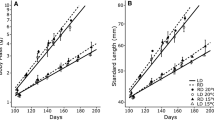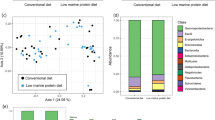Abstract
The purpose of this study was to investigate the effect of freshwater rearing on the fatty acid profiles of the whole body and muscle tissue of the European sea bass (Dicentrarchus labrax). Half of initial fish were gradually acclimated to freshwater (FW) kept at the same temperature to salt water and grown in same conditions as their counterparts in saltwater (SW). The decrease in salinity caused an increase in the percentages of 18:1n − 9, 24:1n − 9, 18:3n − 3, 18:2n − 6 and decrease in the percentages of 14:0, 15:0, 20:0, 21:0, 20:5n − 3 and 22:6n − 3 both in the whole body and in the muscle tissue fatty acid profiles. The lipids of FW-reared fish contained significantly (P < 0.01) higher percentages of 18:2n − 6 and 18:3n − 6 than that of SW-reared fish. However, percentages of 20:5n − 3 and 22:6n − 3 fatty acids decreased significantly (P < 0.05) compared with those of salt water-reared European sea bass. There was a clear trend of decrement in the percentages of n − 3 PUFA fatty acids due to the decrease in water salinity. However, the percentages of n − 6 PUFA fatty acids were also increased with the decrease in water salinity. We concluded that the FW acclimation is followed by changes in certain lipid classes of sea bass muscle tissue and whole body samples. n − 3/n − 6 PUFA ratios were characteristic to previously reported ratios for both FW- and SW-reared European sea bass. In addition, EPA/DHA ratios were basically similar for the fish reared in both SW and FW indicating the equal nutritional value of the final products in terms of providing PUFA’s for human nutrition.


Similar content being viewed by others
References
Ackman RG (1989) Nutritional composition of fats in sea foods. Prog Food Nutr Sci 13:161–241
Alasalvar C, Taylor KDA, Zubcov E, Shahidi F, Alexis M (2002) Differentiation of cultured and wild sea bass (Dicentrarchus labrax): total lipid content, fatty acid and trace mineral composition. Food Chem 79:145–150
AOAC (Association of Official Analytical Chemist) (1990) Official methods of analysis, 15th edn. Association of Official Analytical Chemist, Arlington
Barnabe G (1990) Aquaculture, vol 2. Ellis Horwood, Newyork
Bligh EC, Dyer WJ (1959) A rapid method of total lipid extraction and purification. Can J Biochem Physiol 37:913–917
Boutet I, KyCL Long, Bonhomme F (2006) A transcriptomic approach of salinity response in the euryhaline teleost, Dicentrarchus labrax. Gene 379:40–50
Castell JD, Sinnhuber RD, Wales JH, Lee DJ (1972) Essential fatty acids in the diet of rainbow trout (Salmo gairdneri): growth, feed and conversion and gross deficiency symptoms. J Nutr 102(77):77–86
Chen IC, Chapman FA, Wei CI, Portier KM, O`Keefe SF (1995) Differentiation of cultured and wild sturgeon (Acipenser oxyrinchus desotoi) based on fatty acid composition. J Food Sci 60:631–635
Colin DA, Nonnotte G, Leray C, Nonnotte L (1985) Na transport and enzyme activities in the intestine of the fresh water and seawater adapted trout (Salmo gairdnerii R.). Comp Biochem Phys 81A:695–698
Conides AJ, Glamuzina B (2006) Laboratory simulation of the effects of environmental salinity on acclimation, feeding and growth of wild-caught juveniles of European sea bass Dicentrarchus labrax and gilthead sea bream, Sparus aurata. Aquaculture 256:235–245
Conner WE (2000) Importance of n − 3 fatty acids in health and disease. Am J Clin Nutr 17(1):171–175
Cordier M, Brichon G, Weber JM, Zwingelstein G (2002) Changes in the fatty acid composition of phospholipids in tissues of farmed sea bass (Dicentrarchus labrax) during and annual cycle. Roles of environmental temperature and salinity. Comp Biochem Phys Part B 133:281–288
Czesny S, Kolkovski S, Dabrowski K, Culver D (1999) Growth, survival and quality of juvenile walleye Stizostedion vitreum as influenced by n − 3 HUFA enriched Artemia nauplii. Aquaculture 178:103–115
Daikoku T, Yano I, Masui M (1982) Lipid and fatty acid composition and their changes in the different organs and tissues of guppy, Poecilia reticulate on sea water adaptation. Comp Biochem Phys 73A:167–174
El Cafsi M (2000) Effet de la basse salinite du milieu sur le metabolisme lipidique du Muge. These de Doctorat d`Etat. Universite de Tunis, Faculte des Sciences, Tunis
El-Kardawy A, Salama A (1997) Effect of dietary lipid sources on the growth and fatty acid composition of gilthead seabream (Sparus aurata). In: Tacon A, Basurco B (eds) Feeding tomorrow’s fish. Proceeding of the workshop of the CIHEAM network on technology of aquaculture in the mediterranean (TECAM), Spain, 24–26 June 1996, CIHEAM, Zaragoza, Cah. Options Mediterr, vol. 22, pp 235–241
Eroldogan OT, Kumlu M, Aktas M (2004) Optimum feeding rates for European sea bass Dicentrarchus labrax L. reared in sea water and fresh water. Aquaculture 231:501–515
Haliloglu HI, Bayir A, Sirkecioglu AN, Aras NM, Atamanalp M (2004) Comparision of fatty acid composition in some tissues of rainbow trout (Oncorhyncus mykiss) living in seawater and freshwater. Food Chem 86:55–59
Henderson R, Tocher DR (1987) The lipid composition and biochemistry of freshwater fish. Prog Lipid Res 26:281–347
HMSO UK (1994) Nutritional aspects of cardiovascular disease (report on health and social subjects no. 46), London
IUPAC (1979) Standards methods for the analysis of oils, fats and derivatives, 6th edn. Pergaman Press, London
Jarvis PL, Ballantyne JS (2003) Metabolic responses to salinity acclimation in juvenile shortnose sturgeon Acipenser Btevirostrum. Aquaculture 219:891–909
Kalujnaia S, McWilliam IS, Zaguinaiko VA, Feilen AL, Nicholson J, Hazon N, Cutler CP, Balment RJ, Cossins AR, Hughes M, Cramb G (2007a) Salinity adaptation and gene profiling analysis in the European eel (Anguilla anguilla) using microarray technology. Gen Comp Endocr 152:274–280
Kalujnaia S, McWilliam IS, Zaguinaiko VA, Feilen AL, Nicholson J, Hazon N, Cutler CP, Cramb G (2007b) Transcriptomic approach to the study of osmoregulation in the European eel, Anguilla anguilla. Physiol Genomics 31:385–401
Kelly SP, Chow INK, Woo NYS (1999) Effects of prolactin and growth hormone on strategies of hyposmotic adaptation in a marine teleost, Sparus sorba. Gen Comp Endocr 113:9–22
Kheriji S, El Cafsi M, Masmoudi W, Castell JD, Romdhane MS (2003) Salinity and temperature effects on the lipid composition of mullet sea fry (Mugil cephalus, Linne, 1758). Aquacult Int 11:571–582
Krajnovic-Ozretic M, Najdek M, Ozretic B (1994) Fatty acid in liver and muscle of farmed and wild sea bass (Dicentrarchus labrax L.). Comp Biochem Phys 109A:611–617
López-Olmeda JF, Oliveira C, Kalamarz H, Kulczykowska E, Delgado MJ, Sánchez-Vázquez FJ (2009) Effects of water salinity on melatonin levels in plasma and peripheral tissues and on melatonin binding sites in European sea bass (Dicentrarchus labrax). Comp Biochem Phys Part A 152(4):486–490
Luvizotto-Santos R, Lee JT, Branco ZP, Bianchini A, Nery LEM (2003) Lipids as energy source during salinity acclimation in the euryhaline crab Chasmagnathus granulate, Dana, 1851 (Crustacea-Grapaidae). J Exp Zool Part A 295:200–205
Mozaffarian D, Longstreth WT, Lemaitre RN, Manolio T, Kuller LH, Burke GL, Siscovick DS (2005) Fish consumption and stroke risk. Cardiol Rev 22:5–20
Nakano K, Tagawa M, Takemura A, Hirano T (1998) Temporal changes in liver carbohydrate metabolism associated with seawater transfer in Oreochromis mossombicus. Comp Biochem Phys Part B 119:718–721
Nordrum S, Bakke-Mckellep AM, Krogdahl A, Buddington RK (2000) Effects of soybean meal and salinity on intestinal transport of nutrients in v salmon (Salmo salar L.) and rainbow trout (Oncorhyncus mykiss). Comp Biochem Phys part B 125:315–317
Orban E, Di Lena G, Nevigato T, Casini I, Santaroni G, Marzetti A, Caproni R (2002) Quality characteristics of sea bass intensively reared and from lagoon as affected by growth conditions and the aquatic environment. J Food Sci 6(2):542–547
Pickova J, Morkore T (2007) Alternate oils in fish feeds. Eur J Lipid Sci Tech 109:256–263
Pohl J, Ring A, Hermann T, Stremmel W (2004) Role of FATP in parenchymal cell fatty acid uptake. BBA-Mol Cell Biol L 1686:1–6
Rubio VC, Sanchez-Vazquez FJ, Madrid JA (2005) Effects of salinity on food intake and macronutrient selection in European sea bass. Physiol Behav 85:333–339
Sargent J, Henderson RJ, Tocher DR (1989) The lipids. In: Halver JE (ed) Fish nutrition, 2nd edn. Academic Press, San Diego, pp 153–218
SPSS (1993) SPSS for windows base system user’s guide, release 8.0.2. SPSS, Chicago
Stahl A (2004) A current review of fatty acid transport proteins (SLC27). Pflug Arch Eur J Phy 447:722–727
Steffens W (1997) Effects of variation in essential fatty acids in fish feeds on nutritive value of freshwater fish for humans. Aquaculture 151:97–117
Tseng YC, Hwang PP (2008) Some insights into energy metabolism for osmoregulation in fish. Comp Biochem Phys Part C 148:419–429
Woo NYS, Kelly SP (1995) Effects of salinity and nutritional status on growth metabolism of Sparus aurata in closed water systems. Aquaculture 135:229–238
Zanuy S, Carrillo M (1985) Annual cycle of growth, feeding rate, gross conversion efficiency and hematocrit levels of sea bass (Dicentrarchus labrax L.) adapted of two different osmotic media. Aquaculture 44:11–25
Acknowledgments
The authors would like to thank Dr. O. Tufan Eroldogan for the help given during the experiment. Thanks are also extended to Mr. Haluk Tuncer (Akuvatur Fish Farm) for supplying the European sea bass fingerlings used in this study.
Author information
Authors and Affiliations
Corresponding author
Rights and permissions
About this article
Cite this article
Hunt, A.Ö., Özkan, F., Engin, K. et al. The effects of freshwater rearing on the whole body and muscle tissue fatty acid profile of the European sea bass (Dicentrarchus labrax). Aquacult Int 19, 51–61 (2011). https://doi.org/10.1007/s10499-010-9340-9
Received:
Accepted:
Published:
Issue Date:
DOI: https://doi.org/10.1007/s10499-010-9340-9




